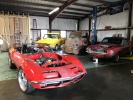2016 silverado 5.3l A6 with texas speed stage 2 (218/226, .635"/.635", 113 LSA, 10% fuel lobe). trans was rebuilt back in Dec. Torque converter was replaced with a billet stock stall speed. Keeping it until their warranty is up and going with a higher stall.
Im trying to figure out if the issue im having is tune related or the torque converter. idle in park/neutral is fine. has a nice quick little lope. As soon as it goes in gear, idle smooths out and the exhaust seems to get louder like its TM advance. On coastdown coming to a stop you can hear the lope and as soon as you stop, idle smooths out again. it didnt always have this. i either have a scewed table or something is going on with the converter. or i could be worried about nothing.
Hoping someone can point me in the right direction.
the log i have is short going from park to drive a couple times. im logging a shit ton of stuff. ill clean it up and get a better log tomorrow. the tune is a maf only tune to check on fueling on the maf side.
thanks!




 Reply With Quote
Reply With Quote


